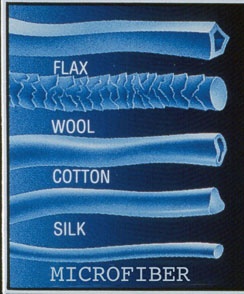Can you clean microfiber?
One of my favorite questions is whether or not we can clean microfiber couches. I love this question, because there seems to be a misconception that microfiber can't be cleaned. Well, I am here to say, definitively, that microfiber is one of the easiest materials a professional upholstery cleaner will run across. There are a few tricks to it, but it is very easy to clean, sanitize and protect.
Microfiber is synthesized from the waste sludge of petroleum products. The fiber is called microfiber because the filament is very small, compared to other fibers, less than .01 denier.

Microfiber is finer than even fine natural fibers (picture from www.fibersource.com)
This means many, many fibers can be woven into each part of the textile. This results in a strong, soft material, that can be very resilient. When used in upholstery, microfiber can also be known as ultra-suede, or faux-suede.
One of the advantages of microfiber is that it is relatively hard to stain, though it will absorb oil and oil based products. So you need to watch out for popcorn butter, steaks, or other oily foods. Lotions, particularly those made from petroleum products, can stain microfiber as well.
When stuff does get spilled onto your couch, the best thing to do is use a wet/dry vacuum to try and suck up as much of the spill as possible. Using a little water in conjunction with the vacuum can help to get more of the spot out. You need to be careful, though, and not use too much water, or water spots can form on the furniture. If water doesn't seem to work, though it should, use a clean microfiber cloth and gently agitate the spot. Using Zerorez® Multi-surface Cleaning Fluid on the spot can be an effective way to remove the stain.
What if your kids decide they want to play with markers or pens on the couch? We've all seen it, those wonderful smiley faces drawn skillfully onto our favorite seat. When dealing with ink, it is best not to start with water, but with a Volatile Dry Solvent (VDS). For ink on microfiber, my favorite VDS is rubbing (isopropyl) alcohol. Don't pour it directly onto the spot, but onto a clean, dry cloth, and gently blot. The drawing should start to disappear quickly! When you get done erasing the artwork, gently mist water over the area and extract it with a vacuum (one that can take moisture). This same process can be used if oils get onto the couch as well, such as the above mentioned popcorn.
The advantage of having the couches professionally cleaned are obvious- we are able to get cleaner, deeper, and faster than if you were to try and use your Bissell. We also have access to better cleaning agents, such as our Zr™ Water, and can re-apply an upholstery safe fiber protector as well. knowing the order in which to clean the various parts also helps, and we have little tricks to get those hard to clean areas, such as arm rests and the cording (that rounded edge piece that can be found on many couches and chairs, but not all). We also know when to stop, because, yes, even though microfiber is an awesome material, it can be ruined as well by over wetting and improper grooming.
Overall, though, microfiber is an awesome choice of fiber for any piece of upholstery, and is durable and easy to maintain. Especially if you have kids or pets, you can't go wrong with a good microfiber couch. And when it's time to clean, every 12-18 months at least, don't forget to call us!